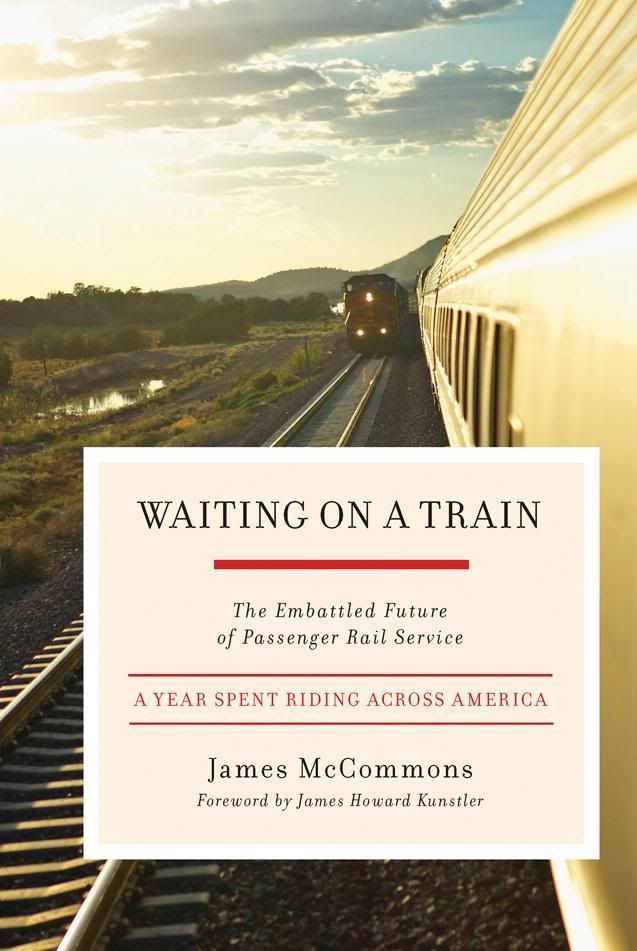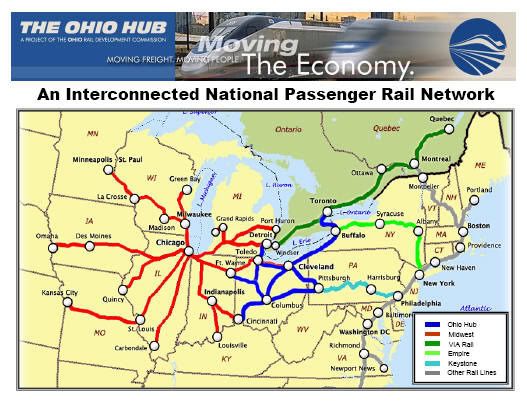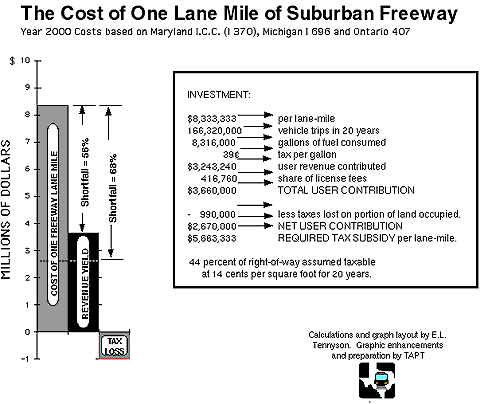Front paged at Docudharma, Hillbilly Report and at ProgressiveBlue, also available in Orange.
 I'm shocked, shocked I say, that a belief tank partly funded by Big Oil and Union Busters would issue a piece attacking High Speed Rail. But they did, claiming that there is a "Coming High Speed Rail Financial Disaster".
I'm shocked, shocked I say, that a belief tank partly funded by Big Oil and Union Busters would issue a piece attacking High Speed Rail. But they did, claiming that there is a "Coming High Speed Rail Financial Disaster".Less shocking is that the argument in the piece is tissue-thin, relying on shell games and appeal to stereotype in lieu of evidence.
Of course, just because its an empty argument does not mean its a pointless one. When you are trying to prevent solutions to problems, FUD ... Fear, Uncertainty and Doubt ... can sometimes be as effective as genuine argument.
Well, I hope someone out there is able to frame great counter-arguments that are useful in cracking into Dr. Utt's (Economics) target audience of those with short attention spans and limited access to information. What I can offer here is raw material for those counter-arguments.
_____________________________
Attack what you can, even if its not the policy on offer
The first red flag that the Heritage piece does not intend a serious consideration of current US Department of Transportation High Speed Rail policy is when the author blithely announces:
Although there is no fixed rule as to what constitutes HSR, a common definition is a rail line that operates at an average speed of at least 125 miles per hour (mph).
If talking about bullet trains alone, this number is low - the very first bullet trains half a century ago were going at these speeds, but there have been a lot of improvements since then. If talking about appreciably faster than what is available at present through the United States ... its high.
 What "at least 125mph" means is the speed where a rail corridor has to be completely grade separated. That's why the Express HSR corridors are not built to be a little bit above 125mph: there is a substantial capital cost to cross over that hurdle, and once crossed, substantial benefit to operating at 170mph, 190mph, or 220mph.
What "at least 125mph" means is the speed where a rail corridor has to be completely grade separated. That's why the Express HSR corridors are not built to be a little bit above 125mph: there is a substantial capital cost to cross over that hurdle, and once crossed, substantial benefit to operating at 170mph, 190mph, or 220mph.As regular readers of the Sunday Train may be aware, outside the Northeast Corridor, the common maximum speed on US rail mainlines is 79mph. If it sounds odd that the speed limit is set exactly one mph below a normal US "count by 5's" speed limit ...
... as James McCommons recounts in "Waiting on a Train", over half a century ago, the Federal Railroad Authority mandated that all railway corridors supporting traffic at 80mph or higher must provide Positive Train Control signal systems for safety. These are systems that can automatically stop trains if a train is going into a track that is already occupied, or if the engineer is incapacitated.
And the railways mostly responded by setting speed limits of 79mph in their corridors. So while the US has the biggest and brawniest trains with massive heavy freight loads compared to most nations worldwide ... by international standards, that's big and brawny and slow.
In nations that already had regular Interurban Express services running 90mph~100mph, the improvements in technology that allow these trains to maintain that speed when going around curves were incremental improvements. "High Speed" was going substantially faster than that.
And so the first Japanese bullet trains in the 1960's went 125mph, and the first French TGV's in the 1980's went 168mph, with the second generation at 186mph ... and the most recent generation of bullet trains is reaching 220mph around the world.
Now, I'm sure Dr. Utt (Economics) knows perfectly well that the High Speed Rail policy that he is pretending to critique involves all three classes of speed that are higher than conventional US passenger rail. He is just setting the bar to create the frame for the very weakest part of his argument, when he considers the 110mph and 125mph classes of Higher Speed Rail.

To sustain these speeds over long routes requires a substantial investment in a secure and exclusive roadbed built to precise standards and tolerances, using equipment that meets the same high standards. As a result, an HSR line costs much more to build and operate than an ordinary passenger rail line. It is believed that only two HSR lines in the world earn enough revenue to cover operating and capital costs: Paris-Lyon and Tokyo-Osaka
Of course, as I've discussed before, "enough [passenger] revenue to cover operating and capital costs" really means, "pay all operating and capital costs by a fraction of the economic benefit, with everyone else benefiting getting a free ride."
And if we were to apply that same standard to the status quo, Interstate Highways ... Interstate Highways cannot even cover their maintenance alone out of gas taxes paid by traffic on the highways, but have always required cross-subsidy by gas taxes paid to drive on city streets. And now, even that cross-subsidy is not enough, and the shortfall is now being made up out of the General Fund.
So its (1) an absurd standard and (2) an absurd standard that High Speed Rail comes closer to meeting than the Interstate Highway status quo.
The cost of alternative Interstate Highway spending is no mere theoretical comparison. The only two 150mph+ Express HSR systems funded in February were in California and Florida, both in areas projected to have growing population and demand for intercity transport, and both of which present a choice between spending less money to provide transport capacity with High Speed Rail, and more money to provide transport capacity with long distance highways and investment in airport expansions.
So one freedom the Heritage Foundation is fighting against is the freedom to spend public capital subsidies in a cost-effective way.
Deficit Errorism Strikes at Rail Projects!

In addition to the high costs that the HSR program will impose on taxpayers during a period of economic hardship and slow recovery,
When applications made for funding, those applications include a cost and benefit analysis that does indeed claim that the total economic benefit exceeds the total cost. Yet Dr. Utt (Economics) has not to this point even pretended to dispute these claims. He simply jumps from "not profitable for a private business to pursue" to "a net cost to taxpayers".
That logical leap is lubricated by bullshit. If the projects yield economic benefits that are substantially greater than the costs, there is no net "cost imposed on taxpayers". Construction of those HSR corridors would impose:
- job opportunities on unemployed and underemployed workers, and
- demand for the product of supplier businesses
... but not net costs on future taxpayers. Instead, the investment in more capital efficient transport more easily powered by domestic sustainable energy yields a net benefit for future taxpayers.
And of course, if there is a particular corridor where the cost of an Express HSR corridor is not justified by the full economic benefit, build a less expensive system ... because Express HSR is just one option.
What there's no argument to make, hope for an ignorant audience
 Of course, after criticizing Express HSR for being too expensive, without bothering trying to prove the point, the next step is to argue that the much less expensive Regional HSR projects are no good either. But I wonder how you could attack Regional HSR for being so much cheaper per mile than Express HSR, after resting your whole argument on the high cost per mile of Express HSR? I wonder ...
Of course, after criticizing Express HSR for being too expensive, without bothering trying to prove the point, the next step is to argue that the much less expensive Regional HSR projects are no good either. But I wonder how you could attack Regional HSR for being so much cheaper per mile than Express HSR, after resting your whole argument on the high cost per mile of Express HSR? I wonder ... One has to wonder what exactly motivated the FRA review team to endorse the proposed $1.1 billion investment in the Kansas City-St. Louis-Chicago route, which would allow customers to reach their destinations 10 percent faster than they could by driving between Chicago and St. Louis.
Actually, no, nobody has to wonder. After existing improvements in bottlenecks with freight, even according to SubsidyScope's attack on Amtrak, the Chicago/St. Louis corridor recovers 80% of its operating costs from operating revenues at Amtrak speeds.
And that is a service that is slower than driving, which means there are trips that are day trips when driving but overnight trips by train.
It puzzling why a fellow economist would have to "wonder" why more people will make a choice when more people gain the freedom to make that choice. Indeed, on the demand side, its the growing freedom to choose that defines the three tiers of High Speed Rail:
- Become time-competitive with driving, and people who would rather spend their trip doing something other than driving, have the freedom to make that choose.
- Become faster than driving, and some people who wanted something faster than driving, especially for inner urban, outer suburban, and rural destinations without a convenient airport, will start choosing the train for the speed.
- Become time-competitive with flying, and some people will choose the train for the greater comfort and the smaller portion of the trip spent waiting for the trip to start.
Given the willingness that Dr. Utt (Economics) has to engage in misleading framing and deceptive shell game arguments, when he has to resort to simply bluffing by "wondering why" for a question with a perfectly obvious and straightforward answer, he must be on very weak ground indeed.
And then cross-reference to fellow HSR deniers
However extravagant this commitment to jazzed-up 19th century technology may be, the ultimate costs of bringing HSR to the 13 corridors already approved by the FRA will be staggering. California received a $2.3 billion grant toward an HSR rail system with an official cost of $50.2 billion (in 2006 dollars), but independent analysts contend that it will more likely cost $81.4 billion.[6]
There's another shell game here:
- shell one is the actual policy
- shell two is the talking point that 110mph diesel and 125mph electric tilt trains, first successfully put into service in the 1950's and not gaining wide use until after active tilt was mastered in the 1980's is "1800's technology"
- shell three is putting the cost of the California system immediately after the reference to the 110mph and 125mph speed classes ... even though California is a 220mph speed service.
 But note the description of a cost quote from what is described as an "independent source". Is it a peer reviewed academic paper? A genuinely independent third party that takes no position on HSR pro or con? No, of course not, its the output of another partly Big Oil funded belief tank, the [http://www.sourcewatch.org/index.php?title=Reason_Foundation "Reason" Foundation]:
But note the description of a cost quote from what is described as an "independent source". Is it a peer reviewed academic paper? A genuinely independent third party that takes no position on HSR pro or con? No, of course not, its the output of another partly Big Oil funded belief tank, the [http://www.sourcewatch.org/index.php?title=Reason_Foundation "Reason" Foundation]:[6]Wendell Cox and Joseph Vranich, "The California High Speed Rail Proposal: A Due Diligence Report," Reason Foundation Policy Study No. 370, September 2008, at http://reason.org/files/1b544eba6f1d5f9e8012a8c36676ea7e.pdf (March 11, 2010).
... by Wendell Cox, who makes much of his living as being the "transport expert" who can be relied upon to deliver the pro-road-lobby conclusion.
Dr. Utt is lying about the independence of that source. Its the output of a belief tank that opposes High Speed Rail. That's not an independent source.
Dr. Utt then surveys the "overseas experience" while conveniently avoiding the fact that every system that he talks about, even the over-priced, badly managed UK investment in HSR, dogged by the politically imposed burden of "public private partnerships", generate operating surpluses. The bedrock foundation of this survey is the demand that everyone else who benefits from a transport service must be given a free ride on the back of passenger fares.
After all this time with shell game arguments, misleading frames, and "one wonders" questions where even a misleading argument must not be available, Dr. Utt saves the lie for very near the end. Blink and you would miss it ... especially for those who believe the lie to be true:
Most taxpayers will continue to travel by more cost-effective and largely self-financed modes, such as cars and airplanes.
Of course, the "self-finance" claim for roads is patent nonsense. Interstate Highways have always been cross-subsidized by people driving on city streets that receive no federal gas tax money, by zoning requirements to provide "free parking", and by a host of other explicit and hidden public subsidies. Unlike High Speed Rail, which can cover its own operating costs, intercity transport by road has been provided both capital and operating subsidy ever since the Interstate Highway System was first established.
None of this is surprising
It we cast our eye back across American Economic History, a watershed event that can be used to divide the Fordist period the followed WWII from the Second Gilded Age that started to gain full speed under Ronald Reagan is American Peak Oil ... and even more specifically, March, 1971, when the Texas Railroad Commission removed the quota on oil production.
When oil prices in the US were regulated through production quotas to remain relatively stable in dollar terms, which means falling prices when corrected through inflation, the interests of Big Oil were lined up with strong income growth. The side-effect that this provides a favorable economic setting for organizing workforces was, for capital-intensive corporations such as big oil, a regrettable but tolerable evil.
When the balance of pricing power passed from an elected Commission in the US to the major oil exporting nations, the interests of oil companies and the economic interests of the United States began to diverge. An over-valued US$ provides US-headquartered transnationals with added economic power when pursuing the rights to exploit non-renewable natural resources overseas. Depressed economic conditions in low-income countries are more appealing than rapid economic development.
When any industry has interests that diverge strongly from the national interest, it becomes useful to invest in propaganda mills to help promote argument frames and talking points that are favorable to their interest and help obscure the national interest.
Each of these propaganda mills are, of course, organizations that chase funding from various foundations and corporations ... so when a single right wing propaganda mill adopts a particular position, it would well be a matter of personal conviction by a group of propagandists wihin the mill. But when the Heritage Foundation, Reason Foundation, Cato Institute all take up the case (see Libertarians Against Choice: The Attack on Obama's HSR Policy and the Midwest HSR Association's HSR Fact versus Fiction) ... well, coming up with arguments that serve the interests of those who pay their bills is the common job of all three.
And so this last week, my "HSR" search tag caught mention after mention of the newest Heritage Institute "argument" against the present High Speed Rail policy.
Your Mission, if you Choose to Accept It ...
So, given what is clearly an effort at deceptive propaganda posing as a serious argument, your mission, if you choose to accept it, is to propose simple, clear, fact based responses to this kind of nonsense. While you ponder that, I'll pass the stage on to the headliners.
Midnight Oil: Truganini


No comments:
Post a Comment